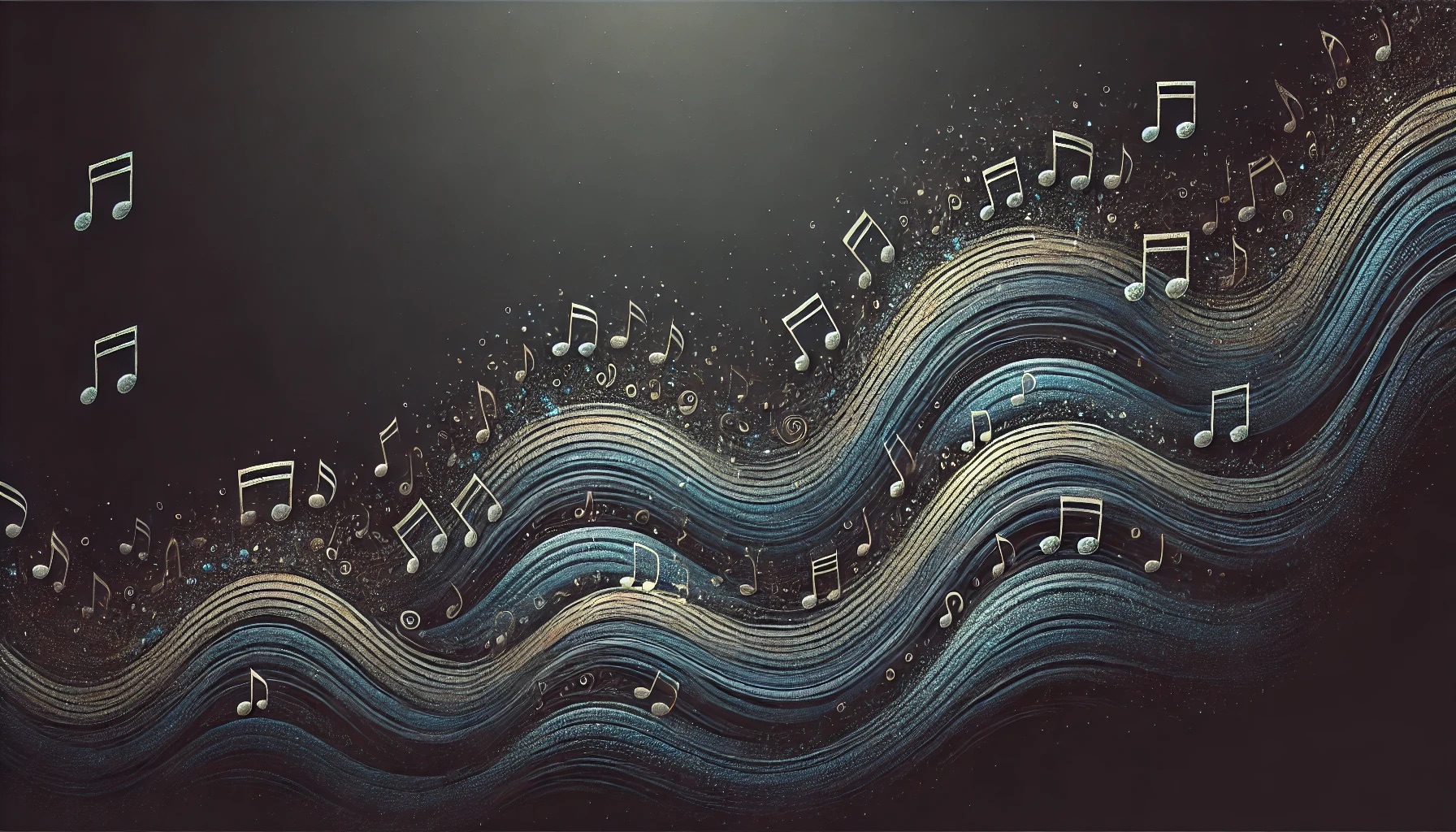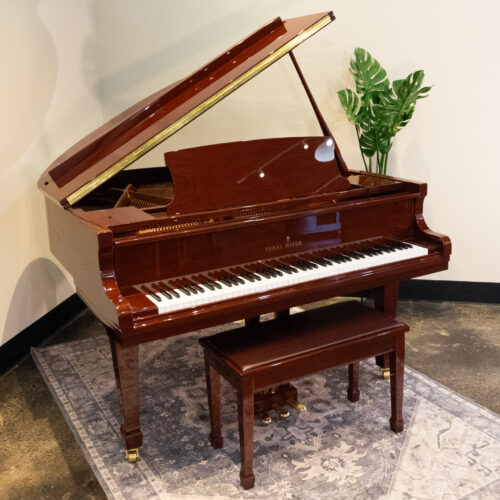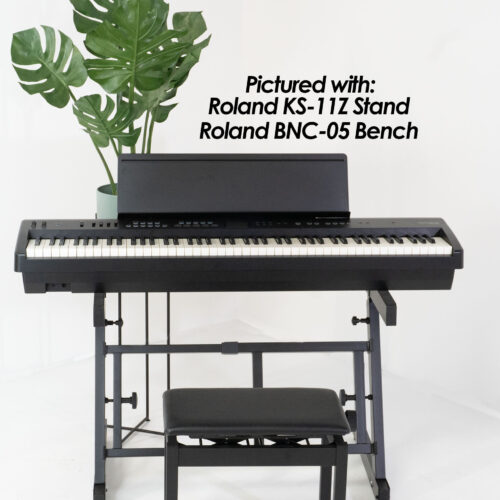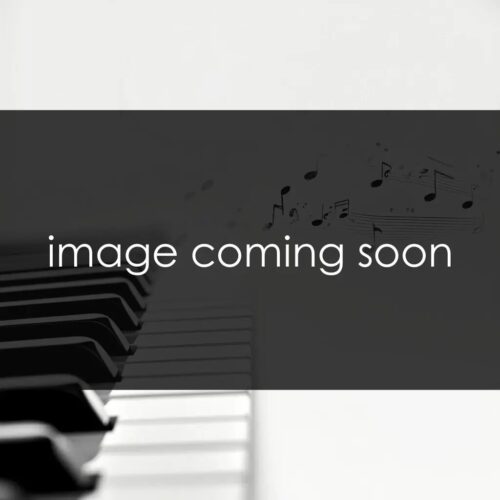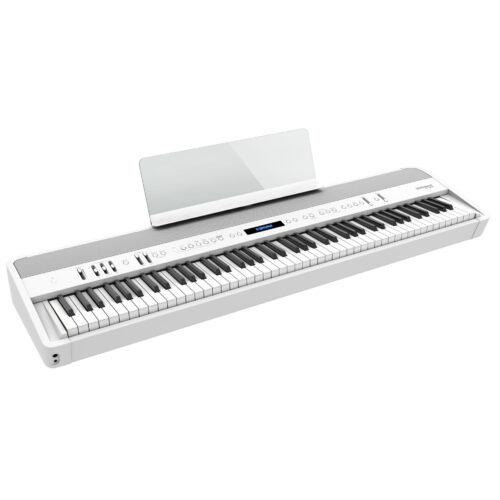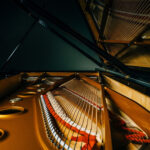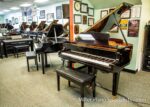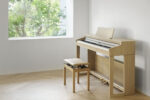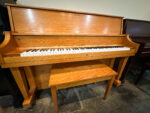
Welcome to Miller Piano podcast episode number 5! It’s Christmas time, and we have a special Christmas treat for you piano lovers out there. In this episode, host Jason Skipper talks with Shana Kirk, a Yamaha Corporation of America consultant and product specialist as well as many many other things, which we learn about in this episode. Shana talks in detail about new piano technology, and how that technology can be used to address common 21st-century learning challenges. Topics discussed:
- Shana’s Personal and Education Background
- Life in Colorado
- Yamaha Disklavier’s Piano Technology in the past 30 Years
- How Shana Became Interested in Piano Technology
- Common Piano Learning Challenges of Today and How the Yamaha Disklavier has Fixed These
- Examples on How Teachers Take Advantage of Yamaha Disklavier’s Tech Features
- How Yamaha’s Acoustic Pianos’ Headphone Technology Works
- Distance Learning Tools
- The Future of Piano Technology
- How You Can Reach Out to Shana
Transcript
Jason Skipper 0:14
Welcome to the Miller Piano Podcast. I’m your host Jason Skipper. And in this episode, we have a talk with special guest, Shana Kirk. Shana is a consultant and product specialist with the Yamaha Corporation of America. She is frequently featured on event programs for organizations throughout the US and Canada. She writes music and music technology-based reviews and articles for blogs, websites and print publications, including Piano Magazine, and American Music Teacher where she co-authors the Tech Connect column. And it was just announced yesterday, I believe, that she is now the Director of Digital operations for the Francis Clark Center, among many, many other things. Shana, it’s an honor to have you with us today. Welcome to the podcast.
Shana Kirk 0:58
Thank you so much, Jason. It’s great to be here.
Jason Skipper 1:00
Did I get all that right?
Shana Kirk 1:02
You did, I think so. It sounds like a lot now that you’ve read it out loud.
Jason Skipper 1:07
Yeah. Well, I tell you, I missed a lot of it. Because honestly, reading from your bio, there’s so much there. I know just looking at your education, it’s incredible. Honestly, I’ve seen there you have a BA in Piano Performance and German from Lipscomb University, Master of music and Piano Pedagogy from the University of Denver and quite a few others that I honestly would just make a fool of myself trying to pronounce.
Shana Kirk 1:34
That German stuff is pretty tough.
Jason Skipper 1:36
Yeah, I was trying, I was looking it up trying to figure out exactly how to pronounce those in German, and I said nope. Maybe you can help us with that. Where else have you studied? What else have you done?
Shana Kirk 1:47
So I spent some time in Germany actually, while I was a student in Lipscomb, and I studied at the Goethe Institute, which is a language school. And I went to the Musikschule, which is a music school in Mannheim. And I spent a little time also at the University of Mannheim. And so I have always enjoyed dipping my toes in a lot of water, I guess. And I just am so fortunate to have a really multi-faceted career and a lot of interest that just keeps me engaged in busy and curious in every possible direction.
Jason Skipper 2:26
That’s awesome. I think to sum it up, I read this on your LinkedIn profile, and it’s really simple and to the point. I love it… it says, “I’m a pianist and a geek. And I combine those two qualities as often as possible”. Is that right?
Shana Kirk 2:40
Exactly, that’s exactly, exactly it.
Jason Skipper 2:42
I love it. I grew up playing the piano. I grew up playing music all my life, but I also consider myself a geek. I do a lot of those type of things. And I love playing with all the possibilities in technology with music, with MIDI and just, you know, working all these different things. So I love it.
Shana Kirk 3:01
There’s never been a more exciting time to just dive into both piano music and music technology and just 21st-century tools. It’s a really, really great, great space to be in these days.
Jason Skipper 3:13
It really is. And I don’t think a lot of people know that, and that’s one of the reasons why we’re doing this podcast is just to let the world know what’s out there. It’s pretty amazing.
Shana Kirk 3:24
Yeah, for sure.
Jason Skipper 3:25
So before we get into today’s topic, we always like to get to know our guests a little bit better, you know, your background where you’re from. So I understand Shana that you mentioned, I know you’re not… you don’t live in Tennessee now, but I believe you are from Tennessee?
Shana Kirk 3:43
That’s right. I grew up in West Tennessee, a little town called Lexington. That’s about halfway in between Memphis and Nashville. I went to Lexington High and my parents still live on a bucolic farm that is right off of Natchez Trace State Park. And so we get back there as often as we can. So I grew up as an absolute Tennessee farm girl who loved music loved all the great harmonies that surrounded me and all the Tennessee music has to offer. And then I went to college right there at Lipscomb. And where that was my first introduction into, you know, really diving into classical music, and really diving into music technology. And I really did have a wonderful experience there.
Jason Skipper 4:27
Wow, wow. Well, where do you live now?
Shana Kirk 4:29
I live right in central Denver.
Jason Skipper 4:31
Okay. And how, you know, just real quick, how did you end up there? How’d you end up in Denver, moving away from Tennessee being so focused on music? How’d you end up in Denver?
Shana Kirk 4:42
I was actually looking for graduate programs after I left Lipscomb. After I graduated from Lipscomb, my now husband and I were both kind of searching the world searching the country at least for places that look like fun and also had Continuing Education and graduate programs that would fit both of our needs and somehow Denver was just the place that we landed on. So it wasn’t really as you know, there were a lot of factors that went into that. But basically, we were looking around for where could we have a great time and continue our education in the same city and Denver hit that sweet spot and once we were here, we just couldn’t think of leaving.
Jason Skipper 5:28
It’s beautiful out there. I’ve looked at it multiple times all out through Colorado in that area, it’s beautiful. The weather at least in the summertime and you know, most of the year is beautiful I know you get snow, I asked you before we started recording this but have you had any snow so far?
Shana Kirk 5:47
There’s actually already been a lot of snow in Colorado. If you’re thinking about coming out for skiing, everything is already open. And, and just really in great shape up in the mountains. Denver has had more snow than we’re used to by this time of year. But today, it’s actually sunny and gorgeous, which is a little secret of Denver is that there are 300 days of sunshine and it’s almost always sunny.
Jason Skipper 6:09
Ah, you’re making me jealous.
Shana Kirk 6:13
Nobody makes biscuits like the Loveless Cafe, which we don’t have.
Jason Skipper 6:19
That’s true, that’s true! In any case, let’s go ahead and get into the topic that we wanted to talk about today. we’re getting into Piano Technology, specifically the Yamaha Disklavier, and addressing common 21st-century learning challenges. Piano technology has changed so much over the years. You mentioned a little while ago, how we live in one of the most exciting times in music and with piano technology. I think that the majority of people, when they think of pianos, they think of a beautiful instrument. A lot of times the classical instrument, the upright or the grand piano, but not a whole whole lot of people, not many people think about technology in the piano. The truth is it has changed a lot. How has piano technology changed over maybe the last 10, 20, 30 or more years?
Shana Kirk 7:09
Well, 30 years is kind of a benchmark in the evolution of technology of the piano, especially the acoustic piano, because that’s when true reproducing pianos that were outfitted with MIDI technology started being produced. So Yamaha’s first Disklavier was about to think a little more than 30 years ago now and it was just a reproducing acoustic piano. But at the center of that was suddenly the ability to measure every single motion, every single gesture that a pianist could make on a piano could be measured in just incredible resolution even as long ago as 30 years.
Shana Kirk 7:55
And in the interim, that has only gotten better. Starting in the mid-90s, Disklavier introduced high-resolution recording. So instead of the 128 increments of media measurement, that was then multiplied by nine. So in the approaching 1000 increments of measurement for every single keystroke, every single hammer hit, every single anything that happens inside of the piano is being measured to unbelievable accuracy. So when you have that kind of accuracy, you can actually reproduce a performance to the standard of a classical artist. In prior iterations of reproducing pianos, say what you might associate with player pianos of the early 20th century. There were actually some very sophisticated instruments even back then, but they couldn’t come close to reproducing the humaneness of a classical performer, with all of the subtleties that are required and studied classical music.
Jason Skipper 8:58
Wow. How did you – I know that you grew up here in Tennessee, and you studied at Lipscomb. But how did you get interested first in piano technology?
Shana Kirk 9:07
So that’s an interesting thing. So when I was a high school student, I was a pretty enthusiastic student, and an enthusiastic musician too. But you’re in kind of a, an isolated area in rural Tennessee, where you don’t know what you don’t know. But I was just fascinated by all things music, and I knew I wanted to be in the music world. And I had played in band and taking piano lessons. And then I got to Lipscomb, and there was this whole other layer of musicianship that I had no clue about. So my teacher was Jerry Reed, who is you know, just a wonderful and award-winning and phenomenal teacher in the area. And I think that he saw a spark and also had a willingness to kind of be hard when it was necessary.
Shana Kirk 9:59
And so he really gave me some guidance about classical music. And then and also just sort of helping me fit into that world because I had been a total, you know, country girl, and I didn’t have a clue. But also at the same time, and this is like, you know, the ironies of growing up in the south, I think I had a small scholarship from the Walton foundation from Walmart. And that scholarship went on top of my other scholarships, and it was actually just cash and they just gave me a check. So with that, check, I marched myself to the music electronic store I don’t even remember the name of it now is the dusty little store in northeast Nashville, and I bought a keyboard and a MOTU interface, orange, and bright-colored MOTU interfaces, and Finale version 2.6.1, the engraving software which came on, you know, three or four floppy disks best I remember, and a MAC classic computer. computer like the little screen, you know, monochrome Mac classic. So that was my rig. And I carried it back and forth to Lipscomb with me in the back of my Ford Escort. And, I discovered at the same time that our theory teacher who was a brilliant brilliant man named Gerald Moore. Dr. Moore, unfortunately, passed away a few years ago, but he had been doing a side gig for many years as an arranger in Nashville. So the idea of using a keyboard to write music into a computer was relatively new and we had started that learning curve at the same time. And so we shared each other’s pain and learning how to do this.
Shana Kirk 11:58
Bfrustrated by how often our computers crashed and how often we couldn’t get the setup to work. I have admitted many times, although probably never on the radio that I got away with not doing a whole lot of my theory homework because I used to try to turn it in on finale and then my computer would crash and I would go to Dr. Moore and I would say Oh, my computer crashed. And he was so, he was this giant, like you know, I don’t know how it seems like he was seven feet tall but he probably wasn’t I don’t know. A lot bigger than me person who would just… but he was sort of like a big, you know, cuddly, you know? He was just this nice, nice person, very, very warm person and he was saying, oh, Shana, I completely understand. You can just turn it in whenever and you would never get around to turning it. Hey, let me slide on so much theory homework. I’ll have to also admit that I ended up taking some remedial theory classes in graduate school.
Jason Skipper 12:58
But hey during that time, you got all the practice in there. So you learned…
Shana Kirk 13:06
Definitely. I had this deep understanding of how MIDI and computers fit together, and you know why that is useful in the real world. Because there was Dr. Moore just doing incredible work in Nashville and increasing his output I think exponentially because all of a sudden, he didn’t have to handwrite everything. There was this easy way. There wasn’t even there was barely an email it wasn’t like you could attach a message to I mean, you couldn’t attach a score to an email or send anything online but at least you could get multiple copies output fast.
Jason Skipper 13:42
Right. Right. That’s awesome. You started From the beginning there. You started really, really early and learned it well.
I think in our correspondence before this episode, you mentioned that the bulk of your work today in your job and everything you do seems to revolve around artists, educators and recording studios who use the Yamaha Disklavier, especially when it can help address common 21st-century learning challenges. Can you explain what you mean by that?
Shana Kirk 14:16
Yeah, yeah, sure. So, I have had a longtime relationship with Yamaha as a consultant, since actually the time I was a graduate student here in Denver. And in that role, I have been in this sort of unique niche of having a big background in classical music and piano pedagogy, but also having this you know, additional layer of knowledge in technology. So Yamaha has hired me now for many years to help educators, especially college music departments. But also private teachers and artists and studios and whatever, to figure out what they needed and how they could be helped by this technology. And since my personal passion is for great acoustic piano performance, a lot of times that has carried over to Yamaha Disklavier.
Shana Kirk 15:18
So, since the very early days of Disklavier, schools have adopted them for the purpose of helping students practice more efficiently. So it’s one thing to practice for, you know, hours and hours like we do as pianists. But a lot of times that turns into things like repetitive stress injuries, or just plain old brain fry exhaustion. So something that was discovered and actually one of the original reasons that the Yamaha Disklavier was ever invented in Japan was to help students take advantage of being able to listen to themselves better. So if you, as an advanced pianist can record a performance on the Yamaha Disklavier, and then step back a few feet, and then experience your own performance as an audience member, or as a critique of your own performance. You develop listening skills and sort of self-assessment skills that you can’t do when you’re just in the middle of playing. So that’s an incredible benefit to being able to have this very realistic performance of yourself just anytime you need to do that.
Jason Skipper 16:35
Right. When you listen back and you hear yourself what you did, because a lot of times when you’re in the middle of it, you don’t realize, you know, you’re messing up in a certain area, you get off time, I guess. I don’t know, I mean…
Shana Kirk 16:48
Yeah, absolutely, there’s that. But then I call it sort of the microscope of a Yamaha Disklavier is when you have that performance. Now, remember that the Yamaha Disklavier, on the backbone of the Disklavier is MIDI. And MIDI is data, MIDI is not a recorded performance. So what can you do with data, you can manipulate it. So because MIDI is data, you can take a display of your performance. And you can speed it up, you can slow it down, you can change the key, you can take little segments out and loop them over and over again. And so anything that you can do in a MIDI studio, you can also do at the Yamaha Disklavier, but the benefit is you’re doing it on a real acoustic piano with all of those, you know, brain-rattling vibrations in the room, all of this specialness of an acoustic piano. So I have been giving workshops for teachers for many years now demonstrating a lot of the ways that you can use Yamaha Disklavier as it’s just a microscopic teaching tool. One short example I’ll give…
Jason Skipper 17:53
Yeah, that would be great.
Shana Kirk 17:55
Say, I saw this in I saw this years and years ago what before I was working so closely with Yamaha in a teacher workshop with Susan Ogilvy who is also, you know, wonderful technology, promoter and just composer and wonderful person. So anyway, I was in this early workshop with Susan Ogilvy. And she had a student come and she was going to show recording and playback as a teaching tool, and she asked the student to play a scale. And the student, she was expecting that the student would miss a few things, and that she would play it back and we would be able to, you know, make note of Oh, you didn’t quite get that, you know, finger passage exactly right, or something like that.
Shana Kirk 18:43
But instead, the student was a total show off and he played really, really fast. And the audience kind of gasped at how great they thought it was maybe or maybe how great he thought of himself. And so it’s right in the moment, Susan said, you know, I’m going to do something a little different here, I’m going to see what your performance sounds like, if I play it at half the speed, you played. And all of a sudden, you hear all of these bumps and uneven places and places where the two hands weren’t exactly together. And suddenly you realize she’s just taken a microscope to that performance and exposed everything about it that was insecure and shaky. And also, sometimes you hear two side by side really fast performances, and you can’t quite put your finger on what, no pun intended there, why one is so much more professional-sounding than the other. Sometimes it’s those microscopic differences in where your hands exactly playing together and was the scale exactly, exactly, even. And that happens across the board, not just in classical music.
Jason Skipper 19:55
Right. What other ways Have you seen and maybe other examples are where teachers are working with their students or maybe schools are maximizing their efforts working with students with the Disklavier. What other ways have you seen that?
Shana Kirk 20:11
So, it’s, it’s a long list. But a couple of my favorite examples are just anywhere when a school or a teacher especially and we all know the burden that is on teachers, especially these days with budget cuts in schools and just incredible schedules that the teachers have to put themselves through. I have a colleague Mario Ajero at Stephen F. Austin State University in Texas, and he has all of his students record their piano proficiency exam. So this is the class that you know group piano or class piano, where piano music students, not necessarily piano students, but any music students have to pass what’s called a piano proficiency. And so at a big school like Stephen F, Austin, that can be an enormous number of students to go through and get and take these exams. So MARIO has all of his students record their exams on Yamaha Disklavier, so that he can come in and, and grade the exams without having to actually schedule with a student. And it just puts so much more flexibility into not just his schedule, but theirs, I mean, students, you know, especially music students are so booked with performances and recitals and even just attending other things. So so that is just a simple way that the Disklavier has to lighten the load of music students and faculty.
Shana Kirk 21:35
And then modern Disklavier, so by modern I mean, just in the last, you know, five or so years, there has been an added element of synchronized video. So most Disklaviers in the last several years, you’re able to connect either a camera, so a video camera, or even just an iPad. There’s an iPad app that goes with the Disklavier called my music recorder. Those two things will let you marry together video of your performance and the physical performance that is on the display here. So how does that help modern competitive piano student? Well, we mentioned I think earlier the avoidance of performance injuries. And there have even been studies about this, you know, NYU, and Washington University, all kinds of things. So when a student can actually see the mechanics of their own performance on a video screen, and then at the very same time, see how a certain gesture of their body translated to a certain sound at the piano. You know, all of a sudden you have all of this information to take in, you can take notes on it, you can work on parts of your physical performance, that you might not be able to observe even from hearing yourself or from independently seeing a video yourself.
Shana Kirk 23:00
So the two of those things put together just give you so much information to assess your own playing and to be a healthier player. I know even probably just now while we’re talking to each other, I tend to be a pretty animated talker. And I realize, you know, one of my shoulders is higher than the other, I’m starting to leap forward in a weird way because I get excited when I talk. And you don’t realize what little tensions you put into your body in ways that you talk in the way that you do your everyday things. When you’re a pianist, and you’re at the piano for hours and hours a day, those little motions in your body, those little tensions can really really multiply. So it’s extremely important for pianists in today’s ultra-competitive environment to have every possible advantage. Be able to reduce those tensions.
Jason Skipper 23:51
Right to be self-aware, understand what they’re doing, what they do, how it comes through in their music and everything they’re doing, so… that’s incredible.
Shana Kirk 24:00
Yeah, it’s critically important. I can’t count the number of pianists that I’ve known that have dropped out of performing life because they have had injuries or because they saw an injury coming and didn’t know how to avoid it. But also, I’ve seen wonderful success stories of pianists who were able to overcome injuries or avoid them in the first place. Just because of technology like the Disklavier.
Jason Skipper 24:27
Right. Wow. Well, you say technology like the discovery, or are these options everything you’re mentioning? Are they more just focused on the Yamaha Disklavier or what other pianos from Yamaha have the same type of options? Is the Disklavier really the one especially in performance things where it’s that’s the standard go to?
Shana Kirk 24:47
I think the Disklavier is certainly setting a standard in every possible way. But Yamaha because it’s such a big and interconnected company and such an innovative company, has carried over a lot of technologies and a lot of ideas across several different instruments. One of the most important ones, I think, is the ability simply to put on headphones. And every instrument Yamaha makes, including most acoustic pianos, are now available with what’s called a silent feature. That, you don’t have to have the playback ability of the disc severe or some of the more sophisticated MIDI features that are in the Yamaha Disklavier to appreciate why you might want headphones on your acoustic piano that solves so many problems for so many families. If you have more than one child in the house, if you have people who go to bed at different times, if you have close neighbors, if you have a student in your family who just is shy about having other people listen – I don’t like other people listening to me, I doubt if most people do. So that is just you know, a problem solver just by itself.
Shana Kirk 26:02
And because the core of the Yamaha Disklavier year revolves around this very, very precise measurement, the one hand, and on the other hand very, very high quality sampled sounds inside your headphones because remember Yamaha is also an electronics company. So many many very powerful sampled sounds come from the Yamaha see FX Concert Grand Piano from the Yamaha C7, which is the standard in every recording studio everywhere, you can ask your Nashville friends. Lots and lots and lots of choices. Yamaha is also the owner of Bösendorfer and that sample is now in a lot of our headphones instruments. And then you get into the very exciting more digital features of something like a Clavinova, where you basically have a multitrack studio at your fingertips You know, tons and tons of artists and educators and composers get tremendous use out of Clavinova. I mean, it’s everything but the kitchen sink right inside the same.
Shana Kirk 27:14
So for someone who may be listening, a listener out there, and they’re trying to understand, you know, I grew up playing piano and I think mom and dad, my mom and dad would have been very happy if I could put headphones into my piano every once in a while, you know? And I guess the question is, you know, for some people out there, how does that work? You take a piano, how can you plug in an acoustic piano, and you plug in headphones, you know, just getting really basic here. How does that work where you can plug it in, and suddenly the piano doesn’t make any sounds anymore? Can you kind of explain that to our listeners?
Shana Kirk 27:49
Oh, sure. It’s actually not that complicated that the mechanism of it is not that complicated. In a Yamaha acoustic piano that has a silent feature or a Yamaha Disklavier the silent feature, there is simply a bar that mechanic, you know, you hear a little motor go bug. And it just prevents the hammers from striking the strings or so then instead of hammer striking strings, they’re just stopped by this little soft bar and it doesn’t make it makes the same sound. I mean, that doesn’t, you know, damage anything. And because the Yamaha Disklavier is based on fiber-optic technology, you’re the hammers are not hitting anything. They’re not hitting sensors or anything like that. They’re simply passing through beams of light. And those beams of light can have unbelievably precise measurements.
Shana Kirk 28:41
So whatever you’re playing on the keys, even if it’s fast, repeated notes, or if it’s very slow movement of the key up and down, all of that is being measured, and then reproduced in a really, really sophisticated modeled sample of an acoustic grand piano. So one of the things that I think is great fun is you put on the headphones in your, you know, living room-sized acoustic piano that’s an upright or small grand maybe that fits into you know, everybody’s living room. And then when you put the headphones on, all of a sudden you’re hearing this nine-foot concert grand.
Jason Skipper 29:19
That’s awesome. That’s awesome. I wish I would have had that growing up. I really do.
Shana Kirk 29:23
I think my family probably wishes they had that growing up.
Jason Skipper 29:28
So one of the things that we’ve talked about here is learning and be able to work with someone who’s somewhere else. A lot of times today, people are moving all over the place. My family, we’ve moved four times probably in the last 10 years. It’s just one of those things that happens a lot of people move all over the place and what happens in today, how can we use the technology and today to be able to let’s say you have a piano teacher somewhere else like another city where you were and you moved away from them, but you don’t want to change teachers you don’t know who to look for, then how could we use this technology for things like that? Or maybe you could give us an example?
Shana Kirk 30:10
Yeah, well, obviously, distance learning is a really hot topic and education circles everywhere. And music education is no different. So the Yamaha Disklavier itself has a feature called remote lesson that is largely limited to institutions. So if you have a great faculty member at your school, and they have some niche expertise, that other people are enthusiastic about, about sharing, you can sort of beam that teacher one piano to the other piano I actually just now helped facilitate a lesson from Frederic Chiu who is a wonderful Yamaha artist and on the faculty of the Hartt School of Music, and, and other positions as well I’ll mention and he was invited to teach a class to some students in Moscow. And so we set up a Yamaha Yamaha Disklavier at the Hartt School of Music, where they have that piano there all the time. And the students in Moscow were able to come to a Yamaha facility there. So Frederic Chiu to has a wonderful way of demonstrating how to create this magical sound in especially the music and the style of Chopin with combining certain subtle movements of pedals and ways to address the keys with velocity, so that’s, you know, the speed of playing a key up and down. And all of that very, very intricate information, just jumped right over those thousands of miles into the piano in Moscow. And students were you could see them on the screen, you know, they were just their jaws were dropped. And these are not students who are new to piano repertoire, but obviously, his approach to this particular topic was so new and refreshing. So that was a really magical thing to watch just very, very recently.
Shana Kirk 32:10
And years ago, I had a more practical application with Inna Faliks, who is on the faculty of UCLA, so University of California in Los Angeles. And she was invited to join that faculty as a very young artist. And that’s not something that you ever turn down if you’re in this world. I mean, faculty jobs in piano are so hard to come by. But she had this existing set of responsibilities in New York City. And on top of that, she had a new baby. And so it was going to be really complicated for her to travel back and forth to take advantage of her new job at UCLA, while not letting everything slide in New York and also while still having a new baby. And so she did manage to do quite a lot of travel and she was very much welcomed on that faculty and she’s doing such a wonderful job there still. But for that early transition, we were able to help her alleviate some of the stress of travel by letting her teach some of her lessons from New York City to LA. So she taught students from Yamaha artist services in New York City and her students and it was really funny because it was in the winter and her students were always wearing shorts and everybody was all bundled up in New York. Sometimes it’s the distance, sometimes it’s the time zone. sometimes it’s just the convenience of life. Sometimes a teacher is sick. Sometimes a student is sick. And just being able to use Distance Learning Tools, either at the Yamaha Disklavier or Clavinova or silent piano can also accommodate Distance Learning Tools if you apply the software. But they discover you are actually has a built-in feature.
Jason Skipper 34:03
That’s awesome. That’s so amazing, I tell you. So real quick finishing up here. Where do you see the future of piano technology going? Where’s the future from today? Do you know? Do you have any clue or?
Shana Kirk 34:18
I have my eye on things, I tell you, I always have my eye on things. Yamaha is always looking into the future. I can tell you that. And Yamaha has done a lot of research and a lot of prototyping in the area of artificial intelligence. That’s still very new in the sophisticated language of music, or to artificial music-making still feels a little artificial, right? Honestly, you can tell when robots playing music right? Instead of when a human is playing music, but the research is there it’s getting closer and closer. I’m also really, really fascinated by how much multimedia is becoming part of our art. So you think of classical piano is this sort of stodgy, snobby world of older people sometimes. And it’s not always used in the same breath as innovative or modern, right. But that’s just not true at all. There is so much to be done. Because of the complexity of classical music. You can put together just unbelievably eye-popping multimedia displays, where the lady from the piano so from the signals from an acoustic performance, are actually creating their own art. So being expressed as visual graphics. And that’s not even hard to do.
Shana Kirk 35:52
There’s an iPad app called Visual Performer that just immediately turns your performance at the keyboard into a multimedia display. But then there are artists like Dan Tepfer, who are also computer programmers, in addition to being great pianist, and he’s a classical pianist and a jazz pianist. And you know, every possible brilliant he could be. And he’s writing algorithms that interpret his playing, and then feed it back to the piano. So it’s like he’s having a duet with his future self. Really, really brilliant stuff. And in the middle of that he has, you know, fractal art. And it’s just unbelievable mind-blowing, mind-blowing things. Then also I am aware of pianists who have very severe limits, pianists who have had strokes. I’ve worked with two great pianists who have had strokes or other conditions that limited one hand or the other, and they’re able to continue playing the piano because they record one part and play along with their own selves at the Yamaha Disklavier. So the accommodations for people who have these abilities. That is a future way of just allowing so many more people to be expressive at the piano. You might have seen a video, there was a really great I think YouTube video of the piano of the singer Renee Fleming controlling a Yamaha Disklavier with brainwaves (See embedded video below). So that’s research, you know, someone who has complete loss of mobility can still control a piano through their brainwaves. So there’s just so much exciting research in the area of accessibility in the area of multimedia, and then you know, distance learning. I’m just waiting for your holograms to be something that I can do.
Jason Skipper 37:46
A hologram dancing on top of the piano while you’re playing.
Shana Kirk 37:48
Oh, yeah. So I do have to mention one multimedia artist before we close. That is really, really exciting. I don’t think she hasn’t done a lot of work on the Disklavier recently, but this just goes to show how long people have been, you know, experimenting with the Yamaha Disklavier as a multimedia instrument. The artist name is Xiao Xiao, X-I-A-O X-I-A-O. But she got hold of a discovery or during the time she was at MIT, and created something called MirrorFugue, where great pianists that she convinced to come in record for her, had their images, the actual images of their hands projected onto the keys. And one of the really special times that happened was she recorded the New Orleans pianist Allen Toussaint. And no one was expecting that it would be one of the last years of his life. And so now we can go back in and see that magical performance you know when he sort of unexpectedly passed away. So it’s a little bit you know, dark to think about, you know, preserving dead pianist. It’s not something that I really tried to emphasize the Yamaha Disklavier. But it is really a wonderful way to preserve moments in history, whether it’s your child’s piano recital, or a great pianist that might have visited your house, or a great pianist, hit what was at a school or a graduate degree recital.
Jason Skipper 39:19
Wow, that’s incredible. I’d say the sky’s the limit. And just everything we can see there. By the way, folks, I’m going to go ahead out. And we’re going to look for all of these things that Shana has mentioned in here, we’re going to put them in the show notes. So if you didn’t look, look through the show notes, you’ll see links to these videos will embed them on the page as well. So check those out. Well, one last thing here. You know, they say there’s a saying you don’t know what you don’t know. And I feel like that today, with you, it’s just been amazing listening to everything that you talk about and that you’re sharing we know that there’s so much technology and everything they’re doing but what haven’t I asked you today that I should have asked or something that you’d like to share with your audience?
Shana Kirk 40:08
So it like I said earlier, it is just an amazing time to be right here at the junction of music and technology and teaching. The truth is you don’t have to be anything like a techie person to enjoy technology at the Yamaha Disklavier or any other technology equipped instrument in 2019. We’re all used to using iPads. The technology has receded into the background. It’s not the goal anymore, it’s just another tool. So if you’re doing something as complex and sophisticated as playing the piano, and if you are, you know, congratulations because you’re keeping your brain going for the rest of your life, adding just a little technology to the mix to make it more engaging and more convenient, is really, really not a big hurdle to cross. We can connect iPad games that make piano play and feel like, feel like a game. You can connect an iPad and have your whole music library, turn the pages for you from right inside your Yamaha Disklavier or any of the keyboard. You can record performances of special people in your life and have them, you know, archived forever. So you shouldn’t feel intimidated and it’s great to have people like Miller Music on hand who know their way around and can give everybody a gentle introduction into what sounds like, you know, a lot of complicated technology but it’s really, really not there is so much to offer now and it can be as hard or as easy as you need it to be. Wow. All right.
Jason Skipper 41:57
Well, how can people find you? I know you have a website, you’re, you write blog posts, you write a lot of different things. How can people find you online? And how can if anybody would ever want to get a hold of you? How can people find you?
Shana Kirk 42:13
Right, so I have my own website, which is pianotopia.net. And I also helped coordinate a website for Yamaha that’s called the Yamaha DEN. So the Yamaha Disklavier Education Network is the DEN. And I try and keep rotating content up there. That is just kind of the latest exciting things to do with Disklavier, especially in ways that education might use.
Jason Skipper 42:38
All right. Well, thank you so much, Shana. It’s been a pleasure to have you on the podcast with us. To our listeners, don’t forget that you can find a transcript with this entire podcast along with show notes and links to all the content that we mentioned the videos and everything else we talked throughout right here on the website. Also, don’t forget to look us up on iTunes, Google Play and Spotify. And subscribe to the podcast leave a rating and a review if you could. I’m your host Jason Skipper. We’ll see you next time.
